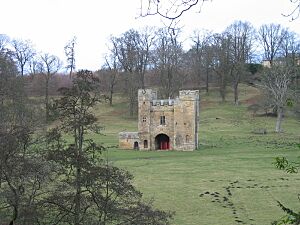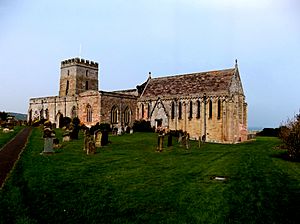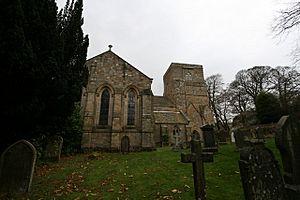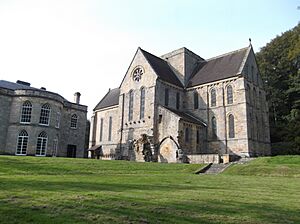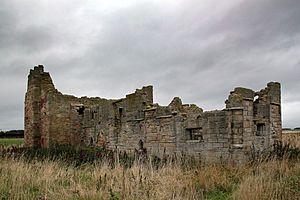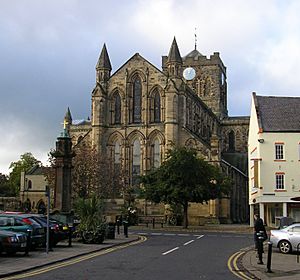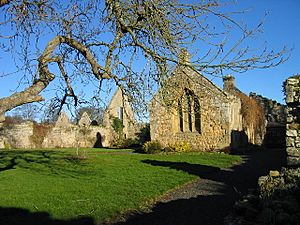List of monastic houses in Northumberland facts for kids
This article is about the monastic houses in Northumberland, England. Monastic houses were special places where groups of people, like monks, nuns, or friars, lived together. They followed strict religious rules and dedicated their lives to prayer, study, and work. These communities played a big role in society long ago.
Northumberland had many such places, from large abbeys to smaller priories and friaries. Some were very old, dating back to Saxon times. Others were built much later, during the Middle Ages. Many of these houses were closed down in the 1500s during a time called the Dissolution of the Monasteries.
Contents
Famous Monastic Houses in Northumberland
Alnwick Abbey
Alnwick Abbey was home to Premonstratensian Canons. These were priests who lived together in a community. The abbey was founded in 1147 by Eustace FitzJohn. It was dedicated to the Blessed Virgin Mary.
The abbey was closed between 1536 and 1539. This was part of the Dissolution of the Monasteries. Today, you can still see parts of the old abbey.
Bamburgh Monastery
Bamburgh had a very old Saxon monastery. It was founded in the 8th century. Sadly, it was destroyed around 875 during raids by the Danes. Today, St Aidan's Church, Bamburgh stands on the same spot.
Blanchland Abbey
Blanchland Abbey was another home for Premonstratensian Canons. It was founded in 1165 by Walter de Bolbec II. The abbey was dedicated to the Blessed Virgin Mary.
It was dissolved in 1539. Interestingly, part of the church is still used as a parish church today. Other old buildings are also still in use, owned by the Lord Crewe Trust.
Brinkburn Priory
Brinkburn Priory housed Augustinian Canons Regular. It was founded around 1135 by William Bertram I. The priory was dedicated to Saint Peter and Saint Paul.
The priory was closed in 1536. Today, it is a beautiful ruin managed by English Heritage.
Chibburn Preceptory
Chibburn Preceptory was a base for the Knights Hospitaller. This was a military religious order. It was founded before 1313.
Hexham Priory
Hexham Priory has a long history. It started as a Saxon monastery and cathedral in 674. It was founded by St Wilfrid and St Etheldreda. The cathedral status was removed in 821. It was then abandoned around 875 due to Danish raids.
Later, in 1113, Augustinian Canons Regular refounded it as a priory. It was dissolved between 1536 and 1537. Today, the church is still used and is known as Hexham Abbey.
Hulne Friary
Hulne Friary was home to Carmelite Friars. It was founded around 1242 by John de Vesci.
The friary was dissolved in 1539. Parts of the church were demolished. In the 18th century, some parts were turned into a house and a summerhouse. It is now called Hulne Priory.
Lindisfarne Priory, Holy Island
Lindisfarne Priory on Holy Island is very famous. It began as a Celtic monastery in 635, founded by St Aidan. It was a very important religious center.
The monastery was attacked and destroyed by the Danes in 793 and abandoned in 875. Later, in 1083, Benedictine monks from Durham refounded it.
The priory was dissolved in 1537. Today, its ruins are a popular historical site managed by English Heritage.
Newminster Abbey
Newminster Abbey was a home for Cistercian monks. It was founded on January 5, 1138, by Ranulph de Merlay.
The abbey was dissolved in 1537. Today, Abbey Farmhouse is built on the site. You can visit with permission.
Other Monastic Houses
- Bamburgh Friary: Home to Dominican Friars, founded before 1265 and dissolved in 1539.
- Bamburgh Priory: A cell of Augustinian Canons Regular dependent on Nostell Priory. It was founded in 1121 and dissolved around 1537.
- Berwick Friaries: Berwick had several friaries, including Augustinian Friars, Dominican Friars (Blackfriars), Franciscan Friars (Greyfriars), Trinitarians (Red Friars), and Carmelite Friars (Whitefriars). Most were founded in the 13th century and dissolved in the 1530s.
- Berwick Priory: A house for Cistercian nuns, founded before 1153. It was dissolved around 1390.
- Bywell Monastery: Records suggest a Saxon monastery existed here.
- Carham Priory: A cell of Augustinian Canons Regular dependent on Kirkham Priory. It was founded in 1131 and dissolved in 1539.
- Coquet Island Priory: First a Benedictine monastery founded before 684, destroyed by Danes. Refounded before 1125 as a cell dependent on Tynemouth.
- Corbridge Monastery: A Saxon monastery for monks, probably from Hexham. Founded before 786 and abandoned before 877 due to Danish raids.
- Farne Island Cell: This was a hermitage for Anchorites (people living alone for religious reasons) before 651. It was abandoned around 800.
- Farne Island Priory: A Benedictine cell dependent on Durham, founded around 1193 on the site of the old hermitage. It was dissolved around 1538.
- Guyzance Priory: First home to Premonstratensian Canonesses around 1147. After the Black Death, it became a cell for Premonstratensian Canons from Alnwick.
- Holystone Priory: Started as a Benedictine nunnery before 1124, then became home to Augustinian canonesses in the 13th century. It was dissolved in 1539.
- Lambley Priory: A house for Benedictine nuns, founded before 1190. It was burned by the Scots in 1297 and dissolved in 1537.
- Merchingley Priory: A cell for Tironensian monks, founded around 1168.
- Ovingham Priory: A cell of Augustinian Canons Regular dependent on Hexham. Founded in 1378 and dissolved in 1537.
- Temple Thornton Camera: A base for the Knights Templar, founded before 1205. It was dissolved between 1308 and 1312.
- Warkworth Priory: A cell of Benedictine monks dependent on Durham. It was ruinous and disused before 1567.
- Warmington Cell(?): This cell of Benedictine monks is cited but has not been clearly identified in Northumberland.
- Yeavering Monastery (?): Crop markings suggest there might have been a monastic settlement here.
See also


